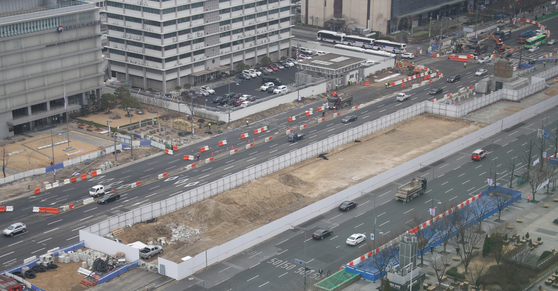
Construction to expand the road to the east of Gwanghwamun Square (in front of the US Embassy in Korea) and the road to the west (in front of Sejong Center for the Arts) as a plaza. yunhap news
The road operation near Gwanghwamun Square in Seoul will be changed starting at 0 o’clock on the 6th. The road on the west side of the Sejong Center for the Performing Arts is closed, and the east road, which used to be a one-way lane, turns into a two-way traffic. It is a change due to the restructuring of Gwanghwamun Square.
Analysis of “similar speed after two-way traffic” in Seoul
Announcement of comprehensive transportation measures to stabilize the new transportation system
The Seoul Metropolitan Government is planning to minimize traffic inconveniences such as traffic congestion by operating comprehensive transportation measures, but asked to use public transportation rather than a car until the surrounding traffic stabilizes.
Is there any problem with the changing traffic flow of Gwanghwamun?
As a result of analyzing a 1.5km radius around the square with a traffic simulation program, Seoul predicted that traffic congestion, which some were concerned about, would not occur. It was revealed that if the new comprehensive traffic plan is activated, the average travel speed for all sections of Sejong-daero will be similar to the pre-construction level (about 21km/h) even after two-way traffic on the east road. It was found that the length of the waiting line for the intersection was reduced by 29% from 184m to 131m. The simulation analysis in Seoul was based on the premise of the stabilization of traffic.
However, on some roads, such as the north-to-south section of Sejong-daero intersection, the waiting line was found to be longer than before construction even after the comprehensive traffic countermeasures were in operation. Regarding this, Gangjin-dong, Seoul’s traffic management manager, said, “Up to 100m long, if you look at a car, there may be a waiting area of 20 cars.
“Vehicle congestion will not be significant even after the end of the corona”

Gwanghwamun Square in Seoul under restructuring. Reporter Kim Seong-ryong
Manager Kang replied, “I don’t think it will increase again even after the corona is over,” he said in response to concerns that traffic will increase again after the end of Corona 19 and vehicle congestion will not intensify. “Compared to 2018 when the road space reorganization project started, the total traffic volume reduction rate in Seoul last year was not as high as 3.8%.”
The Seoul Metropolitan Government plans to implement comprehensive transportation measures with the Seoul Police Agency until the new transportation system is stabilized. The main goal is to establish a left turn at an intersection that can be detoured from Sajik-ro and Yulgok-ro, which meet Sejong-daero, to the surrounding roads, and to adjust the signal operation of 13 intersections of six major roads. Signal operation coordination began on the 4th.
In addition, it was decided to increase the number of subway lines 1, 2, 3 and 5 passing through the area, and to intensively deploy traffic control personnel such as police at 13 major intersections. For the construction of Gwanghwamun Square, the east road sidewalk is blocked halfway and is under construction, but it is said that the sidewalk will be expanded by about 2.2m after the construction is completed.
Hwang Bo-yeon, head of the city traffic department in Seoul, said, “We will carry out comprehensive transportation measures without a hitch so that vehicles can flow smoothly. I beg you,” he said.
Reporter Choi Eun-kyung [email protected]
![]()
